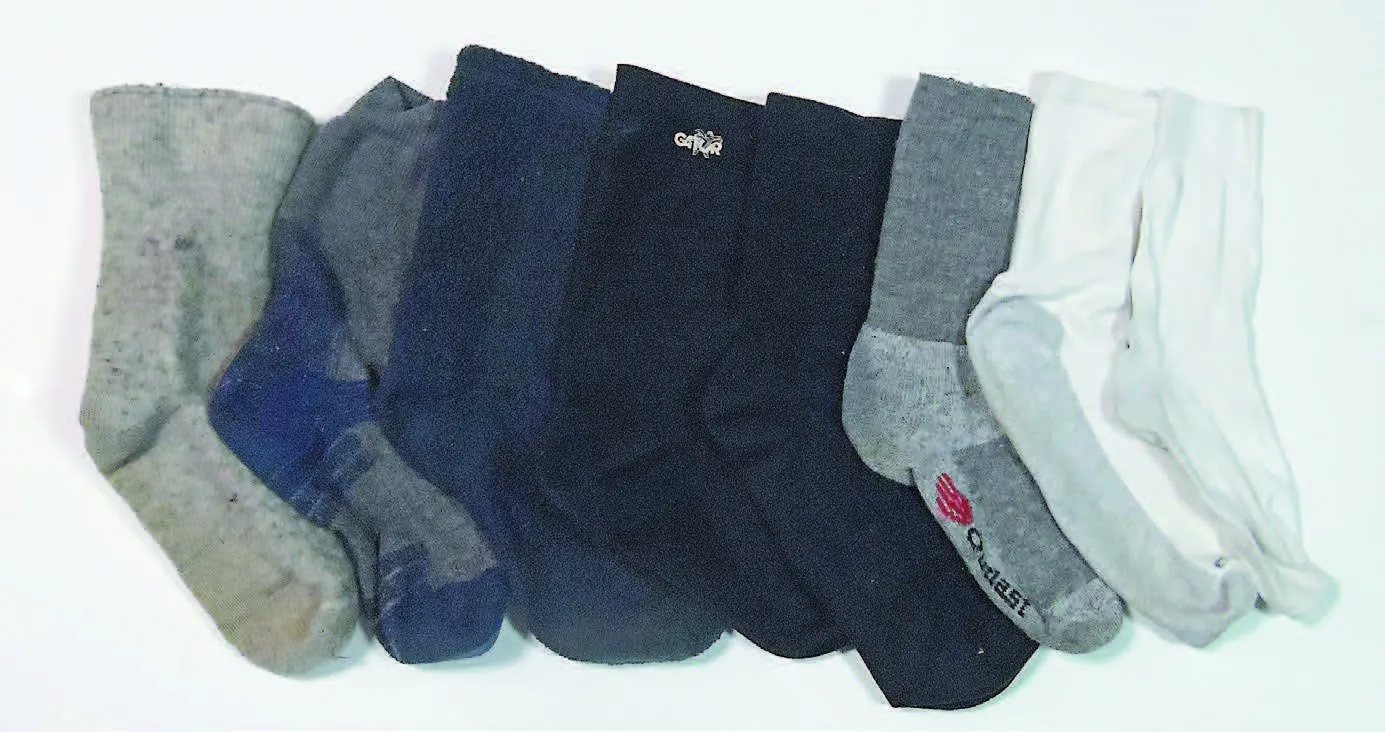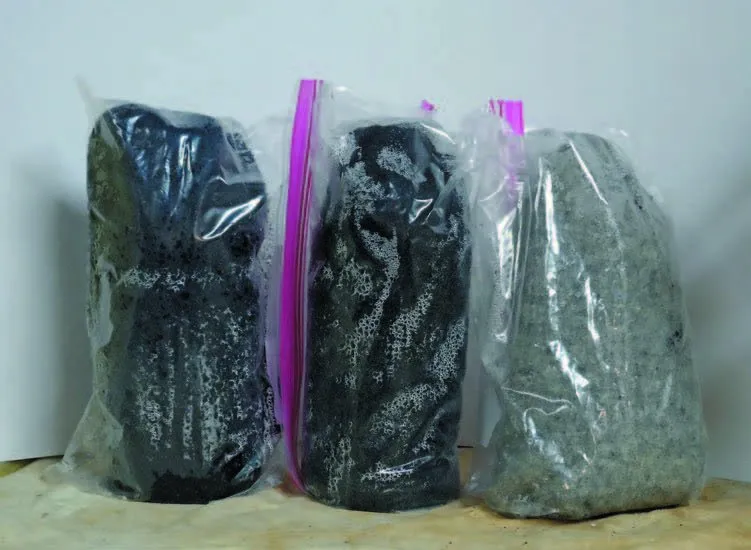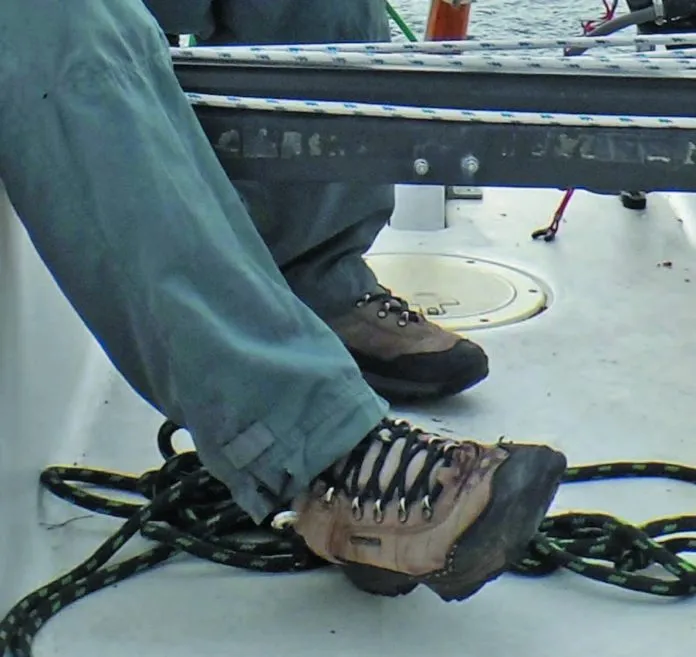We can endure a great deal in the name of good sailing, but cold, wet feet chill us through, and wed rather not resort to heavy sea boots. Regardless of the weather, even in winter, we prefer deck shoes if possible.
But what to wear underneath? If were wearing a dry suit, which we often do for kayaking or sailing in wet or cold weather, any warm socks will do, so long as they are not too thick. The drysuit and the wetsuit boots, which are sized for extra layers, keep the socks dry. In cold, dry weather, weve found a pair of Gore-Tex hiking shoes with a soft, high-traction, non-marking sole will keep our socks dry through the occasional splash. In the summer, well, they just get wet.
It doesn’t take long for a cruising sailor to discover that wet or dry, the choice of socks is nearly as important as the choice of shoes.
Personal preferences play an important role in any decision regarding clothes. We each have an opinion on which materials are warmer and more comfortable. But how much of those preferences are based in facts?
Two properties important to sailing socks, insulating ability (both wet and dry) and drying time, are relatively easily to quantify through testing.
Unlike hats and sweaters, socks have little variation in design, so the results from a sock test can be more widely applied to other clothes items, such as mid-layer pullovers, made of the same material or material blend.
What We Tested
We looked at socks made of cotton, polypropylene, polyester fleece, polyester pile, wool, and neoprene. These were selected because they are representative of the generic types, and because these materials are also used for base layers, and mid-layers. Moderately used samples were selected rather than new ones from the store. Clothes don’t stay new for long, so there is little point in testing them that way.
How We Tested
We measured the thickness of each sock by compressing them uniformly between a pair of thin fiberglass sheets and measuring with a micrometer. We then filled a 16-ounce sports drink bottle with 140 F water (uniformly heated in a laboratory hot water bath), slid it into a sock with the top folded over, and sealed that into a 1-gallon freezer bag. They were left on a table at room temperature for two hours, and the temperature drop was measured with a laboratory thermometer.
First we tested them dry, then we soaked the socks for one hour, allowed them to drip off for 15 minutes, and repeated the testing. Finally, we tested them wrung-out, since drying may not always be an option and clothing is not always completely sodden.
To test dry times socks were sealed in freezer bags to limit the effect of evaporation. Mid-layers are worn under foul weather gear and sock are worn inside shoes; both restrict evaporation. Our test was designed to take this into account, allowing very limited evaporation.
After one hour in the bags, we hung the socks to dry in 65 F, measured weight loss over time, and recorded how long it took before they felt dry and had returned to their dry starting weight.


Observations
Perhaps the most obvious result is how small the difference in the insulating values for each type of sock. This is an artifact of the wind blocking effect of the bag. The colder the weather, the more vital a wind-proof shell becomes. At temperatures near or below freezing a shell must be more than wind-resistant. It must form a windproof seal. Yes, you still need some ventilation to prevent condensation, but venting must be strictly controlled. Winter air is very dry, so ventilation does not to be excessive.
Heat loss when dry has far less to do the material of construction than the weave and thickness. All of the materials were relatively effective insulators when dry. However, the picture changes dramatically when socks get wet. Cotton, for example, provides very little insulation when wet.
Neoprene, which we expected to be an excellent choice for wet conditions, is no better than thin fleece and doesn’t dry any faster. Wool and fleece, on the other hand, retain much of their insulation value even when wet. Thickness roughly correlated with insulating property-wet or dry. Wool blends had no advantage over synthetics.
The differences and drying time were considerable. Liner socks were dry within 10 hours and fleece within 20 hours, while cotton and wool required 2 days to fully dry in cool conditions. Neoprene was no faster to dry than wool. Fleece was the only insulating material that would have been wearable after drying overnight. Often in expedition conditions, the clothes may have to be wrung out and worn until dry, since the only heat source is your body and humidity may be very high.
Feel is important for both socks and base layers, yet it can be highly subjective. Cotton was comfortable when dry, but clammy when wet. Liner socks felt vaguely clammy most of the time, and neoprene seemed both clammy and ready to raise blisters. Polyester fleece and fine wool are generally comfortable next to the skin, whereas coarse wool and polyester pile are better suited for mid-layers.
Because our focus was on materials, not the ever-changing world of clothing products, in many categories we tested only one product.
Cotton
Our cotton representative was a pair of Lanesboro Sport Athletic Socks.
When dry, cottons insulation value was roughly proportional to thickness. Once they got wet, they felt the coldest and lost heat faster than a naked bottle.
Bottom line: These socks were warm and comfortable in dry weather only. Take lots because you will change often.
Polypropylene
Our test polypropylene sample was a liner sock of unknown brand. Polypropylene has a slipperiness that reduces blistering, and it dries quickly. However, the material also adds no meaningful insulation. Despite these drawbacks, they are useful for tender feet under heavier socks.
Bottom Line: Recommended for under heavier socks.
Wigwam Blend (Outlast)
The trademark Outlast fiber is a 25 percent wool/ 70 percent acrylic blend. Blended socks are comfortable for walking, but we found them to provide ineffective insulation.
Bottom line: Good day hiking socks.
Gator Neoprene Socks
We wore these for years under wet suit boots. Eventually, we realized they were hard to put on, hard to take off, and even wet, were not as warm as Acorn fleece.
Bottom line: Were not fans of neoprene socks and have retired ours. Neoprene dive boots-on the other hand-have proven very useful for various activities on board or ashore.
Acorn Fleece Socks
As soon as it becomes too cool for cotton, these are our go-to socks. They fit inside deck shoes just like cotton socks but are considerably warmer, particularly when wet. They dry reasonably fast and are not uncomfortable when wet. For extreme cold (ice climbing) we may layer heavy fleece socks over them, but not for sailing, since sailing is generally above freezing. They were the fastest drying among warm socks, and we have worn them dry many times.
Bottom line: This is our best choice for most cold weather activities.
Pile Socks
Pile socks are similar to fleece, but thicker and with a rougher texture. Our test pair was Wyoming Wear (no longer available). Pile is not particularly fast-drying unless wrung out tightly.
Bottom line: Recommended for extreme conditions.
Bridgedale Summit
A 45 percent wool/ 60 percent acrylic blend, weve found these to be very comfortable for a third-layer sock in mountaineering boots, but the drying and wet insulation properties are not impressive. They took days to dry, particularly in the elastic.
Bottom line: Not for sailing.
Dachstein Boiled Wool
These socks from Dachstein Wool Wear are the traditional standby for cold weather wear, the high wool content (85 percent wool, with nylon for shape and elastic) translates into slightly improved wet performance. Unfortunately, they took days to dry; on any sort of expedition, you never expect them to be fully dry without heat.
Bottom Line: These have been replaced by fleece in our climbing and sailing wardrobes.
Conclusions
We reaffirmed our preference for Acorn Fleece Socks for cold and wet weather. Although not quite as comfortable as dry cotton, they stay warm, dry fast and do not affect fit of shoes. We like cotton against the skin in warm weather, but as soon as the water gets uncomfortably cool we switch to fleece.
High-wool content socks performed well, but only if youre going home for the night or if the boat has heated drying capabilities. Wool blends were disappointing when wet. Synthetic base layers have a well-earned reputation for odor when compared to wool. We have not found this to be true of socks or mid-layers, most probably because they dry faster.
































